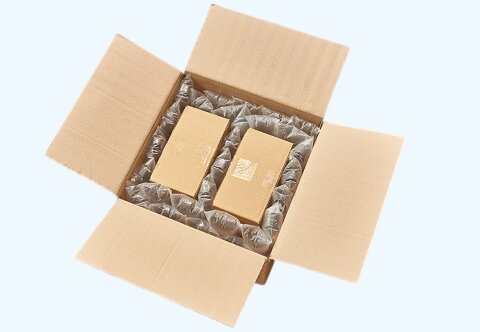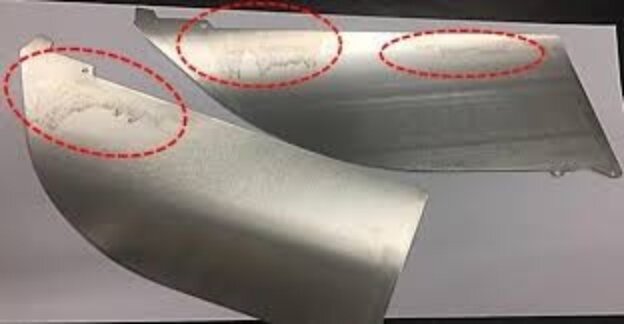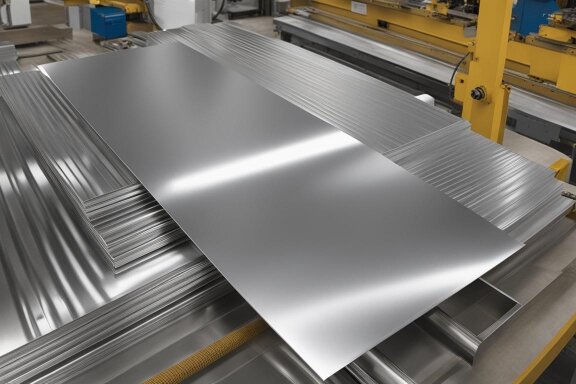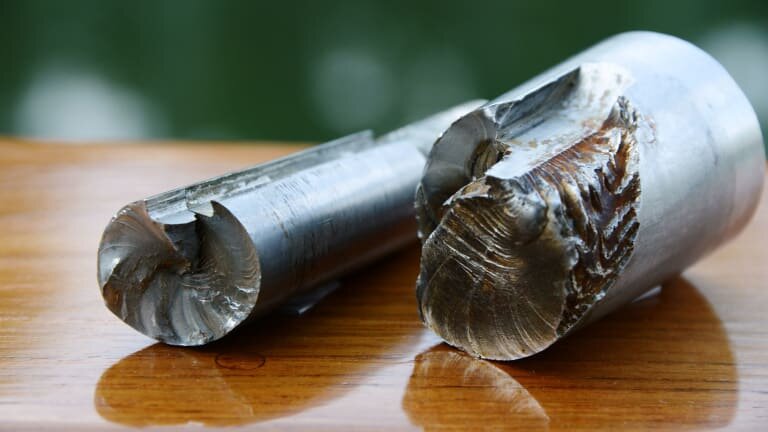Dans la fabrication des métaux, la coupe et le pliage sont souvent les opérations les plus importantes. Mais ce qui façonne réellement la résistance et l'aspect d'une pièce vient après ces étapes : la finition. Un traitement de surface approprié peut transformer une pièce ordinaire en une pièce qui résiste à la rouille, à l'usure et aux effets des années d'utilisation. Sans ce traitement, même les pièces bien fabriquées peuvent tomber en panne prématurément.
La finition et le revêtement de la tôle protègent les pièces des environnements difficiles. Ils améliorent les performances et l'aspect des pièces et maintiennent leur fiabilité dans le temps. Que vous conceviez des pièces, achetiez des composants ou gériez la production, le choix de la bonne finition peut avoir un impact significatif sur la durabilité et la qualité.
Cet article examine plusieurs méthodes standard de finition et de revêtement, notamment le revêtement par poudre, l'anodisation, la galvanoplastie et la passivation. Chaque méthode présente ses propres avantages. En comprenant comment les différentes finitions affectent la solidité, la résistance à la corrosion et l'apparence, vous pourrez faire des choix plus éclairés qui amélioreront les performances et la durée de vie de votre produit.
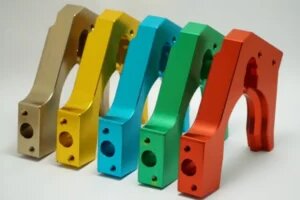
Qu'est-ce que la finition de la tôle ?
La finition de la tôle est l'étape finale de la fabrication qui améliore l'aspect, la résistance et les performances d'une pièce. Elle fait appel à des méthodes mécaniques, chimiques ou électrochimiques pour traiter la surface du métal. Ces procédés permettent d'éliminer les défauts mineurs, de lisser les zones rugueuses et de préparer les pièces pour les revêtements ou la peinture. La finition ajoute également une couche protectrice qui aide à prévenir la rouille, la corrosion et l'usure de la surface.
Une bonne finition peut transformer un métal nu en une pièce prête à être utilisée à long terme. Elle peut arrêter l'oxydation dans des conditions humides ou extérieures et réduire le frottement entre les pièces mobiles. Les finitions facilitent également le nettoyage des pièces et leur permettent de conserver leur aspect plus longtemps.
Types courants de finition de la tôle
Chaque méthode de finition possède ses propres atouts en fonction de la fonction de la pièce et de l'environnement de travail. Voici quelques-unes des finitions les plus populaires et les plus efficaces utilisées pour les pièces en tôle.
Microbillage
Microbillage utilise de délicates billes de verre et de l'air comprimé pour nettoyer et lisser les surfaces métalliques. Ce procédé permet d'éliminer la rouille, l'oxydation et les marques d'usinage tout en conservant les dimensions précises de la pièce. Il crée une surface mate ou satinée avec une rugosité d'environ Ra 1,0-3,0 μm, ce qui en fait une base appropriée pour un revêtement ou une peinture ultérieurs.
Il est souvent utilisé sur l'acier inoxydable, l'aluminium et l'acier doux. Le microbillage améliore l'adhérence du revêtement et donne aux pièces un aspect propre et uniforme qui dissimule les imperfections mineures de la surface. Il s'agit d'un excellent choix lorsqu'un aspect homogène et une texture fine sont requis.
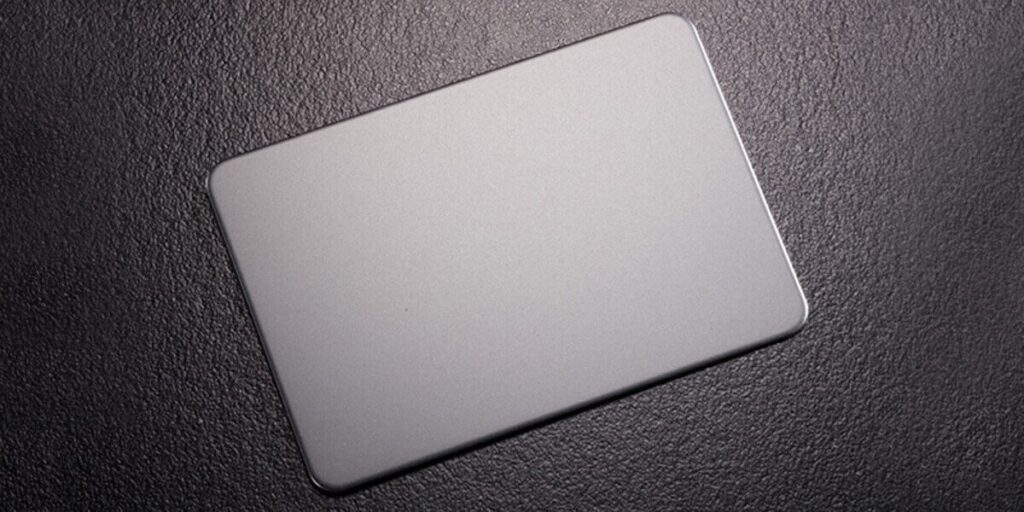
Revêtement par poudre
Revêtement en poudre consiste à pulvériser des particules de poudre chargées sur une surface métallique mise à la terre, puis à les faire durcir dans un four à 180-200°C. La poudre fondue forme un film continu et durable d'une épaisseur comprise entre 60 et 120 μm.
Ce revêtement offre une excellente protection contre la corrosion, les chocs et les dommages causés par les UV, ce qui le rend adapté aux applications intérieures et extérieures. Les pièces revêtues de poudre conservent leur couleur et leur brillance pendant des années, avec un minimum de décoloration ou d'écaillage. Avec un grand choix de couleurs et de textures, cette finition est largement utilisée pour les boîtiers, les meubles et les pièces de machines qui ont besoin à la fois de résistance et d'attrait visuel.
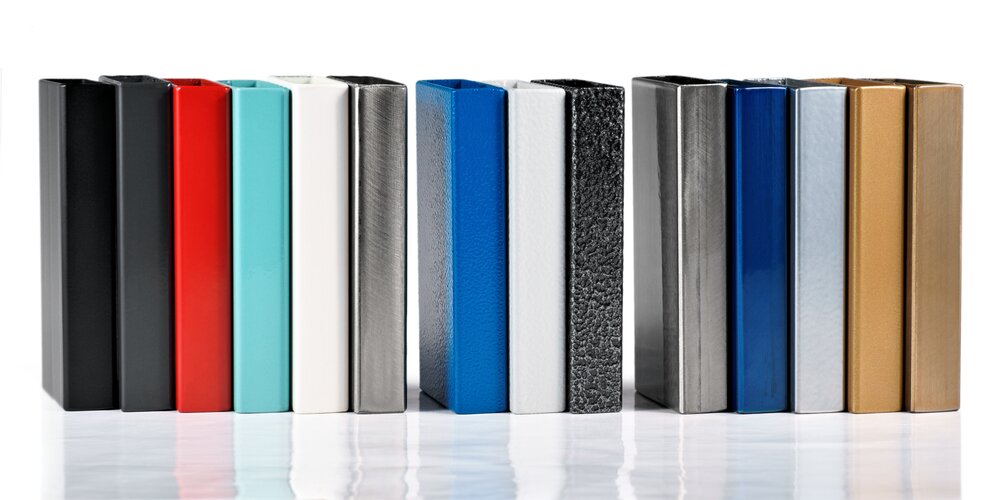
Peinture
Peinture ajoute une fine couche de 30 à 50 μm de revêtement liquide pour protéger le métal et ajouter de la couleur. La surface est nettoyée et parfois traitée avec une couche de phosphate pour améliorer l'adhérence de la peinture. Les pièces sont ensuite cuites à 120-150°C pour durcir la peinture et augmenter sa durabilité.
Différentes peintures sont utilisées à des fins différentes :
- Peinture époxy offre une forte résistance chimique et convient parfaitement aux machines industrielles.
- Peinture acrylique sèche rapidement et convient parfaitement aux meubles d'intérieur ou aux présentoirs.
- Peinture polyuréthane résiste à la lumière du soleil et à la pluie, ce qui le rend idéal pour les applications extérieures.
La peinture est flexible en termes de couleurs et d'options de finition, et elle est rentable pour les prototypes ou les petites séries. Bien qu'elle ne soit pas aussi résistante que le revêtement par poudre, elle donne une surface attrayante, facile à nettoyer et dotée d'une solide protection contre les intempéries.
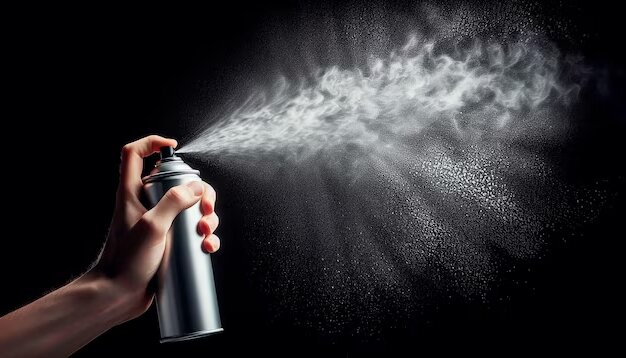
Galvanoplastie
Galvanoplastie utilise un courant électrique pour recouvrir une pièce d'une fine couche d'un autre métal, tel que le zinc, le nickel ou le chrome. Le revêtement a généralement une épaisseur de 2 à 25 μm.
- Revêtement en zinc offre une résistance à la corrosion et un aspect argenté brillant.
- Nickelage ajoute de la dureté et de la résistance à l'usure.
- Chromage offre une finition miroir d'une grande durabilité.
Les pièces galvanisées sont couramment utilisées dans les secteurs de l'automobile, de l'électronique et de la décoration, où l'aspect et les performances sont essentiels.
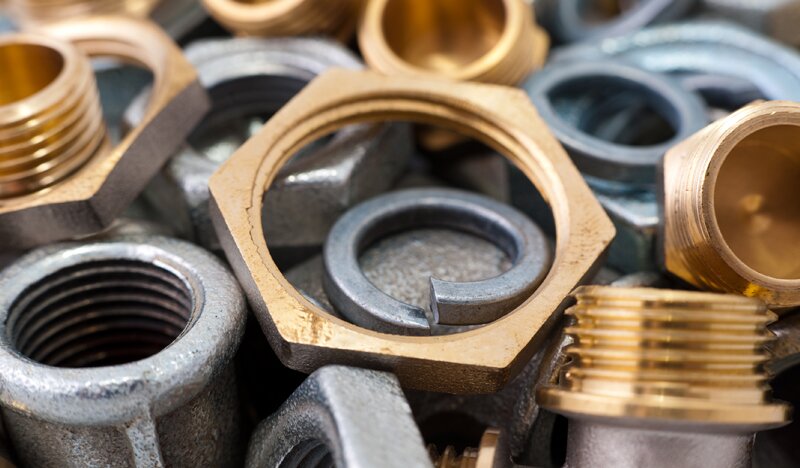
Anodisation
Anodisation est principalement utilisé sur l'aluminium pour améliorer la résistance à la corrosion et la dureté de la surface. La pièce d'aluminium est placée dans un bain d'acide, et un courant électrique forme une couche d'oxyde étroitement liée de 10 à 100 μm d'épaisseur.
L'aluminium anodisé peut être teinté dans une grande variété de couleurs. La teinture étant absorbée par la couche d'oxyde, elle ne s'écaille pas. La surface est ensuite scellée dans de l'eau chaude pour fermer les pores et fixer la couleur.
- Anodisation de type II (acide sulfurique) est couramment utilisé par les consommateurs et les architectes.
- Anodisation de type IIIL'anodisation dure, également connue sous le nom de hard anodizing, crée une couche plus épaisse et plus dure pour les pièces de l'aérospatiale et de l'industrie.
Les pièces anodisées offrent également une forte isolation électrique, ce qui les rend adaptées aux boîtiers, aux dissipateurs thermiques et aux composants électroniques.

Passivation et film chimique
La passivation améliore la résistance à la corrosion de l'acier inoxydable en éliminant le fer libre et les impuretés de la surface. Elle forme une fine pellicule d'oxyde invisible sans modifier l'aspect de la pièce.
Pour l'aluminium, un revêtement de film chimique tel que la conversion au chromate offre une protection similaire. Ces revêtements sont fragiles, mesurant généralement moins d'un μm, et maintiennent la conductivité électrique tout en résistant à l'oxydation. Ces deux traitements sont couramment utilisés dans les boîtiers et les assemblages électriques où la conductivité et la résistance à la corrosion sont essentielles.
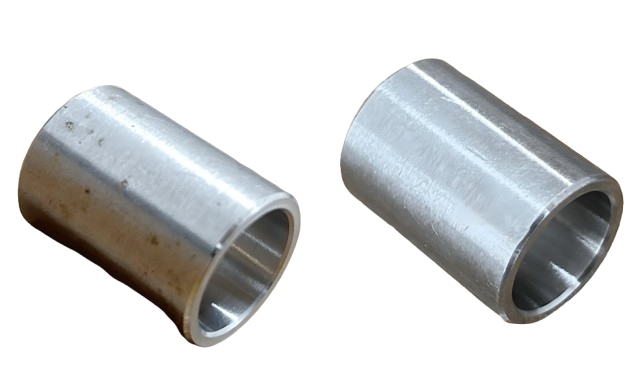
Revêtement électronique
E-coating, également connu sous le nom de revêtement électrophorétiqueLa peinture est appliquée uniformément à l'aide d'un champ électrique. La pièce est immergée dans un bain de peinture à base d'eau, chargée, puis cuite à 160-190°C. Le revêtement final a généralement une épaisseur de 20 à 35 μm, couvrant même les formes complexes et les angles serrés.
L'e-coating offre des finitions lisses et brillantes avec une excellente résistance à la corrosion. Il est largement utilisé dans la production automobile et électroménager parce qu'il offre une couverture uniforme, une forte adhérence et une résistance à l'écaillage et à la décoloration.
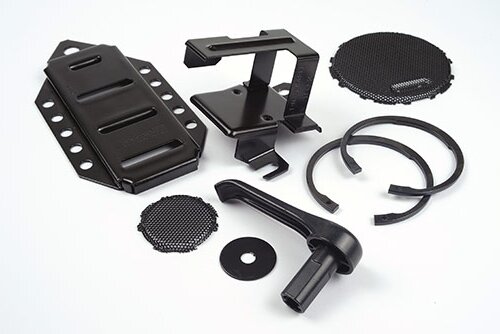
Noircissement à chaud
Noircissement à chaud, également appelé revêtement d'oxyde noirL'oxyde d'aluminium forme une fine couche noire sur l'acier ou le fer. Les pièces sont plongées dans une série de bains chimiques chauffés qui créent une couche d'oxyde d'environ 1 μm d'épaisseur.
Cette finition offre une légère protection contre la corrosion, réduit les reflets et donne un aspect sombre uniforme. Elle est couramment utilisée pour les outils, les fixations et les pièces de précision qui nécessitent un aspect propre et professionnel tout en conservant des dimensions serrées.
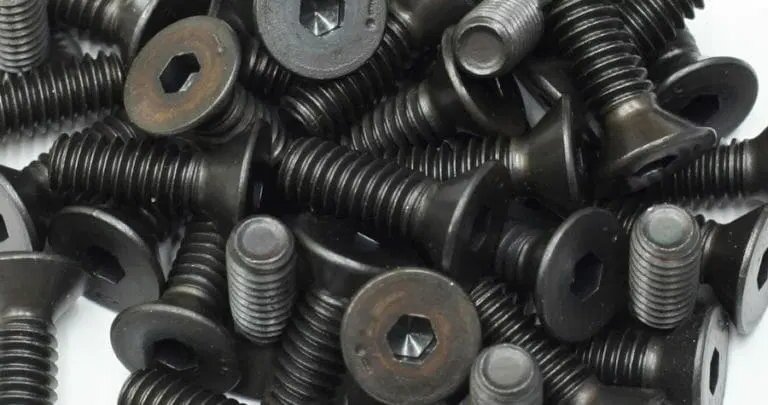
Comment la finition de la tôle améliore les performances?
Finition de surface Le traitement de surface ne se contente pas d'embellir les pièces : il a un effet direct sur leurs performances et leur durée de vie. Chaque type de traitement de surface joue un rôle crucial dans la protection de la pièce et la minimisation des coûts à long terme.
Résistance à la corrosion et à l'usure
Les pièces métalliques sont souvent soumises à des conditions difficiles, telles que l'humidité, les produits chimiques ou le frottement. Sans une finition appropriée, ces facteurs peuvent provoquer de la rouille, de l'oxydation ou une usure de la surface. Les finitions telles que le revêtement par poudre, l'anodisation et la galvanoplastie créent une couche protectrice qui prévient ces problèmes. Par exemple, un boîtier en acier revêtu de poudre peut résister aux intempéries pendant des années, tandis que l'aluminium anodisé reste stable dans les environnements humides ou marins.
Les finitions protègent également contre l'usure mécanique due à des contacts ou des mouvements répétés. L'anodisation dure et le nickelage rendent les surfaces plus complexes et plus résistantes aux rayures et à l'abrasion. En réduisant la corrosion et l'usure, la finition des surfaces contribue à prolonger la durée de vie de la pièce et à réduire les coûts d'entretien - un avantage clé tant pour la production que pour l'utilisation quotidienne.
Avantages sur le plan de l'esthétique et de l'image de marque
Une finition de qualité donne à un produit un aspect professionnel et de grande valeur. Les revêtements lisses et uniformes donnent aux pièces un aspect précis et durable, ce qui renforce la confiance des clients dans la marque. Les finitions, telles que le revêtement en poudre et la peinture, sont disponibles dans une large gamme de couleurs et de textures, ce qui permet aux entreprises de s'adapter à leur image de marque et à leurs objectifs en matière de design.
Pour les produits de consommation, l'aspect et le toucher comptent autant que la fonction. Une surface satinée ou un revêtement en poudre brillant sont synonymes de qualité et d'attention portée aux détails. Outre l'aspect, les finitions empêchent également la décoloration et l'altération de la couleur, ce qui permet aux produits de conserver leur aspect propre au fil du temps.
Performance électrique et thermique
Certaines finitions améliorent la capacité d'une pièce à supporter l'électricité ou la chaleur. L'électrodéposition de nickel ou de cuivre améliore la conductivité électrique, ce qui la rend idéale pour les terminaux, les connecteurs et les composants électroniques. D'autre part, l'aluminium anodisé fournit une isolation là où les pièces doivent bloquer le flux de courant, comme dans les boîtiers ou les dissipateurs de chaleur.
Les finitions peuvent également améliorer le transfert de chaleur. Les revêtements protecteurs qui réduisent l'oxydation maintiennent des performances thermiques stables, en particulier dans les composants tels que les blocs d'alimentation ou les modules LED. Le choix de la bonne finition en fonction des besoins électriques ou thermiques garantit un fonctionnement sûr et efficace de la pièce dans des conditions réelles.
Comment choisir la bonne finition pour la tôle ?
Chaque pièce a des besoins différents en termes de performances, et la meilleure finition dépend de l'endroit et de la manière dont elle sera utilisée. Le bon choix améliore à la fois la fonction et l'apparence. Voici les principaux points à prendre en compte lors de la sélection d'une finition.
Comment faire correspondre la finition au matériau ?
Les métaux réagissent différemment aux méthodes de finition. Le matériau de base détermine les traitements qui adhéreront bien et assureront une protection durable.
L'aluminium se prête le mieux à l'anodisation, qui renforce sa dureté et offre un large éventail de couleurs. Il s'associe également bien au revêtement par poudre ou à la peinture lorsqu'une résistance à la corrosion ou une décoration supplémentaire est nécessaire.
L'acier inoxydable bénéficie surtout de la passivation et du microbillage, qui le nettoient et le protègent sans réduire sa résistance naturelle à la corrosion. Pour un aspect plus sombre ou plus brillant, il est possible d'utiliser le revêtement E ou l'électropolissage.
L'acier doux a besoin d'une protection plus forte car il rouille facilement. Le zingage, le revêtement par poudre et la peinture sont des choix courants pour former une barrière solide contre l'humidité et l'oxydation.
Le cuivre et le laiton sont souvent utilisés avec des revêtements transparents ou du nickelage pour éviter le ternissement tout en conservant leur couleur métallique. Chaque métal réagissant différemment à son environnement, le choix d'une finition compatible garantit à la fois des performances durables et une apparence attrayante.
| Finition | Acier Carbone | Acier inoxydable | Aluminium | Alliages de cuivre | Acier galvanisé |
|---|---|---|---|---|---|
| Oxyde noir | Convient pour les outils, les fixations et les attaches ; ajoute une légère résistance à la corrosion. | Pas d'utilisation typique. | Ne convient pas. | Ne convient pas. | Ne convient pas. |
| Galvanoplastie | Utilisé pour les revêtements de zinc, de nickel ou de chrome afin d'améliorer l'apparence et la protection contre la corrosion. | Généralement inutile en raison de la résistance naturelle à la corrosion. | Pas d'utilisation courante. | Souvent utilisé pour les finitions décoratives ou protectrices du nickel et du chrome. | Non recommandé. |
| Anodisation | Ne convient pas. | Ne convient pas. | Commun pour les pièces en aluminium ; améliore la résistance à l'usure et la stabilité de la couleur. | Ne convient pas. | Ne convient pas. |
| Peinture | Finition courante et peu coûteuse ; ajoute une protection contre la corrosion et les intempéries. | Fonctionne comme une barrière supplémentaire ; couleurs personnalisables. | Finition flexible pour les prototypes et les produits de consommation. | Résiste à la couleur et au ternissement. | Souvent utilisé pour les pièces extérieures nécessitant une uniformité visuelle. |
| Revêtement par poudre | Revêtement durable et résistant aux chocs, utilisé pour les machines et les pièces extérieures. | Idéal pour les applications industrielles nécessitant à la fois durabilité et apparence. | Finition décorative populaire avec une forte protection contre la corrosion. | Appliqué pour une protection durable de la couleur. | Améliore la résistance à la corrosion des pièces pré-revêtues. |
| Passivation | Sans objet. | Améliore la résistance à la corrosion et la stabilité de la surface. | Ne convient pas. | Ne convient pas. | Ne convient pas. |
| Polissage | Améliore le lissage de la surface et l'apparence. | Finition miroir ou brossée. | Améliore la réflectivité et la douceur. | Utilisé à des fins décoratives. | Améliore l'aspect et la propreté de la surface. |
| Sablage | Nettoie l'oxydation et prépare les surfaces pour le revêtement. | Élimine le tartre et améliore l'adhérence de la surface. | Crée une texture mate uniforme. | Utilisé pour nettoyer et texturer avant la finition. | Préparer la surface pour la peinture ou le revêtement en poudre. |
Quel est l'environnement opérationnel de la pièce ?
L'environnement a un impact significatif sur la durée de vie d'un poisson. Les pièces utilisées dans des environnements humides, salés ou chimiquement riches nécessitent une résistance élevée à la corrosion. Le revêtement par poudre et l'anodisation sont bien adaptés aux applications en extérieur ou à proximité de l'eau. Pour les applications intérieures, la galvanoplastie ou la passivation offrent généralement une protection suffisante.
Lorsque les pièces sont exposées à la chaleur, au frottement ou au contact avec d'autres composants, il convient de choisir des finitions capables de résister à l'usure mécanique. Pour les équipements médicaux ou alimentaires, les finitions lisses et nettoyables, telles que l'acier inoxydable poli ou l'aluminium anodisé, sont idéales.
Quels sont vos besoins en matière de performance ?
Chaque finition offre des avantages mécaniques et fonctionnels différents. Pour la résistance à l'abrasion, utilisez l'anodisation dure ou le nickelage. Pour la conductivité électrique, choisissez le zingage ou le revêtement par film chimique, qui maintient un bon contact entre les surfaces métalliques.
Si la cohérence visuelle est votre objectif, l'E-coating et le thermolaquage permettent d'obtenir une couleur et une brillance uniformes. Les pièces mobiles bénéficient de surfaces plus lisses qui réduisent le frottement et préviennent l'usure prématurée. L'adaptation de la finition à l'utilisation de la pièce permet de maintenir les performances et la fiabilité au fil du temps.
Quelles sont vos contraintes budgétaires et temporelles ?
Le coût et le calendrier guident souvent les décisions en matière de finition. La peinture par pulvérisation et le microbillage sont abordables et rapides, ce qui les rend adaptés aux prototypes ou aux petites séries. Le revêtement par poudre et le revêtement par électrophorèse nécessitent des temps de préparation plus longs, mais sont plus efficaces pour la production de masse.
Si le temps est compté, choisissez des finitions dont le temps de durcissement ou de séchage est court. Pour des économies à long terme, investir dans des finitions durables permet de réduire les coûts d'entretien et de remplacement.
Quelle apparence voulez-vous obtenir ?
La finition de la surface définit l'aspect et le toucher du produit. Une finition mate ou brossée donne un style industriel, tandis qu'un chromage ou un revêtement en poudre brillant donne un aspect moderne et haut de gamme.
La couleur, la brillance et la texture influencent la façon dont les clients perçoivent la qualité. Les concepteurs choisissent souvent des finitions qui correspondent à l'image de leur marque tout en trouvant un équilibre entre la performance et le coût.
Capacités de finition et de revêtement de Shengen
Chez Shengen, nous accompagnons les projets du prototype à la production. Nous offrons un ensemble complet de services de finition et de revêtement. Nous mettons l'accent sur une qualité stable et des délais de livraison rapides.
Nous gérons plusieurs options de finition en interne pour garder le contrôle et la vitesse :
- Revêtement en poudre: Nous proposons une variété de textures et de niveaux de brillance. Le revêtement adhère bien et dure à l'extérieur. Il convient aux boîtiers, aux cadres et aux pièces structurelles.
- Peinture: Nous assortissons rapidement les couleurs pour les prototypes et les petites séries. La finition est lisse et propre.
- Sablage et microbillage : Nous nettoyons et lissons la surface avant de la revêtir. La texture mate permet à la peinture ou à la poudre de mieux adhérer.
- Polissage et brossage : Nous améliorons l'aspect, éliminons les fines rayures et obtenons une finition satinée ou miroir.
Nous travaillons également en partenariat avec des ateliers de traitement de surface de confiance pour les besoins spécifiques :
- Anodisation (types II et III) : Nous améliorons l'aluminium en lui conférant une meilleure résistance à l'usure et à la corrosion. Nous proposons des couleurs transparentes, noires et personnalisées.
- Galvanoplastie : Nous ajoutons du zinc, du nickel ou du chrome pour la protection ou l'amélioration de l'apparence. Nous améliorons également la conductivité lorsque cela est nécessaire.
- E-Coating : Nous produisons un film lisse et uniforme sur des formes complexes. Le résultat est de qualité supérieure et homogène.
- Passivation: Nous traitons l'acier inoxydable pour améliorer sa résistance à la corrosion sans modifier son aspect ou sa texture de surface.
Vous pouvez nous envoyer vos dessins et spécifications. Notre équipe examinera votre matériel, vos objectifs et votre budget. Nous établirons un devis précis avec les délais de réalisation et les notes techniques.
Nos ingénieurs peuvent vous aider à comparer les choix. Nous pouvons vous expliquer quand le revêtement par poudre est plus performant que l'anodisation, et quand une autre finition est plus appropriée. Faites-nous part des détails de votre pièce et nous vous fournirons une consultation gratuite sur le traitement de surface ainsi qu'un devis.
FAQ sur la finition de la tôle
Voici les réponses à quelques questions courantes sur la finition et le revêtement des surfaces de tôle. Ces détails peuvent vous aider à planifier votre processus de finition avec des attentes claires.
Puis-je personnaliser la couleur ou la texture de ma finition ?
Oui. Nous offrons la possibilité de personnaliser les couleurs conformément aux normes RAL ou Pantone. Le revêtement par poudre, la peinture et l'anodisation permettent d'obtenir une large gamme de couleurs et de textures de surface - des finitions douces et mates aux finitions brillantes. Pour l'harmonisation des marques, nous pouvons effectuer des tests sur des échantillons avant la production afin de confirmer la précision et la cohérence des couleurs.
Quelle est l'épaisseur des revêtements habituellement appliqués ?
L'épaisseur du revêtement varie en fonction du type de finition et des besoins fonctionnels :
- Revêtement en poudre: 60-120 μm
- Peinture au pistolet : 30-50 μm
- Anodisation : 10-100 μm (selon le type II ou le type III)
- Galvanoplastie : 2-25 μm
- E-Coating : 20-35 μm
Nos techniciens vérifient l'épaisseur du revêtement tout au long de la production afin de garantir une couverture uniforme et une protection adéquate.
Quel est le délai d'exécution typique pour la finition ?
Les délais dépendent du processus et de la taille de la commande. Les finitions simples, telles que le microbillage ou la peinture, prennent généralement de 3 à 5 jours pour les petits lots. Les finitions plus avancées, telles que l'anodisation ou la galvanoplastie, peuvent prendre de 7 à 10 jours, y compris la préparation de la surface et l'inspection. Les grandes séries sont planifiées pour garantir à la fois une qualité élevée et un délai d'exécution rapide.
Les pièces peuvent-elles être retravaillées ou finies si nécessaire ?
Oui, dans la plupart des cas. Les revêtements tels que la peinture, le revêtement en poudre ou l'anodisation peuvent être décapés et réappliqués. Le processus exact dépend du matériau et du type de finition. Les pièces minces en aluminium, par exemple, doivent être manipulées avec précaution pour ne pas être endommagées. Avant de procéder au retraitement, notre équipe inspecte chaque pièce afin de trouver la solution la plus sûre et la plus rentable.
Proposez-vous des certifications ou des tests de qualité ?
Oui. Toutes les pièces finies sont soumises à des contrôles d'adhérence, d'épaisseur et de surface avant d'être expédiées. Sur demande, nous pouvons fournir des certificats RoHS, des résultats d'essais au brouillard salin et des rapports de dureté pour répondre aux exigences de qualité spécifiques de votre projet.
Hey, je suis Kevin Lee

Au cours des dix dernières années, j'ai été immergé dans diverses formes de fabrication de tôles, partageant ici des idées intéressantes tirées de mes expériences dans divers ateliers.
Prendre contact

Kevin Lee
J'ai plus de dix ans d'expérience professionnelle dans la fabrication de tôles, avec une spécialisation dans la découpe au laser, le pliage, le soudage et les techniques de traitement de surface. En tant que directeur technique chez Shengen, je m'engage à résoudre des problèmes de fabrication complexes et à favoriser l'innovation et la qualité dans chaque projet.

